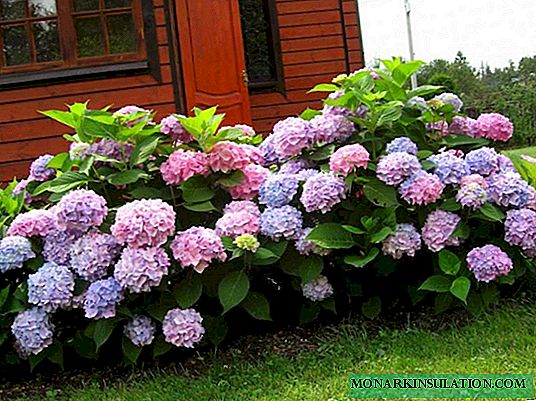
After acquiring a land plot, a summer resident begins to solve the most important problems: you need to start with something in order to settle down. The most important thing is to provide yourself with water. Indeed, since life was born in water, without it all life cannot exist for a long time. It is possible to bring water from somewhere, but only for personal needs. The watering problem cannot be solved by this method. It is good if there is water at least near the site. Will arrange any, even a small, reservoir: a river or at least a brook. An ideal option is a spring, but it is rarely lucky. It remains to acquire a pump. By the way, at first, a homemade water pump is suitable. Its use will relieve the severity of the problem.
Option # 1 - American River Pump
Such a pump model, for which operation does not need electricity, can be used by craftsmen who are fortunate enough to purchase a site on the shore of a small but very stormy rivulet.

The hose is laid in a barrel in even turns without creases and excesses. And the whole structure as a whole looks rather unpretentious, but water with its help is regularly delivered to the shore
To create a pump you will need:
- a barrel with a diameter of 52 cm, a length of 85 cm and a weight of about 17 kg;
- hose wound in a barrel with a diameter of 12 mm;
- outlet (feed) hose 16mm in diameter;
There are restrictions for the immersion environment: the working depth of the stream should not be less than 30 cm, the speed of movement of water (current) - 1.5 m / s. Such a pump provides the rise of water to a height of not more than 25 meters vertically.

Components: 1- outlet hose, 2- sleeve coupling, 3-blades, 4-polystyrene foam floats, 5 - spiral winding of the hose, 6 - inlet, 7- bottom of the structure. The barrel keeps afloat perfectly
Details of the use of this pump can be seen in the video.
Option # 2 - a makeshift wave pump
The operation of this pump also takes advantage of the river that is located nearby the site. In a reservoir without a current, such a pump is unlikely to be effective. To make it, you will need:
- corrugated pipe type "accordion";
- bracket;
- 2 bushings with valves;
- log.
The pipe can be made of plastic or brass. Depending on the material of the "accordion" you need to adjust the weight of the log. A log weighing more than 60 kg will correspond to a brass pipe, and a less heavy load will do for a plastic one. As a rule, the weight of the logs is selected in a practical way.

This version of the pump is suitable for the river and not with the most rapid flow, it is important that it simply was, then the "accordion" will be reduced, and the water will be pumped
Both ends of the pipe are closed with bushings having valves. On the one hand, the pipe is attached to the bracket, on the other - to a log placed in the water. The operation of the device directly depends on the movement of water in the river. It is her oscillatory movements that must make the accordion act. The expected effect at a wind speed of 2 m / s and with an increased pressure of up to 4 atmospheres can be about 25 thousand liters of water per day.
As you know, the pump is presented in a simplified form. It can be improved if you exclude unwanted torque for the log. To do this, we fix it in the horizontal plane, installing an annular stopper on the elevator with the help of a bolt. Now the pump will last longer. Another improvement option: soldered tips at pipe ends. They can simply be screwed onto.
Particular attention should be paid to the preliminary preparation of the log. Do not forget that it will be placed in water. We prepare a mixture of natural drying oil and kerosene at the rate of one to one. We impregnate the log itself with a mixture 3-4 times, and cuts and ends, as the most hygroscopic, six times. The mixture may begin to solidify during operation. When heated in a water bath, it will return fluidity without loss of other properties.
Option # 3 - pressure difference furnace
Craftsmen, whose idea was embodied in this miracle of engineering, called their brainchild "oven-pump." They, of course, know best, but at the initial stage of their work, this pump looks like a samovar. However, he really does not heat water, but creates a difference in pressure, due to which his work is carried out.
For such a pump it is necessary:
- 200 liter steel barrel;
- Primus or blowtorch
- branch pipe with tap;
- mesh nozzle for a hose;
- rubber hose;
- drill.
The nozzle with a tap must be cut into the bottom of the barrel. Close the barrel with a screw plug. In this plug, a hole is pre-drilled and a rubber hose is inserted into it. The mesh nozzle is needed in order to close the second end of the hose before it is lowered into the pond.

This pump option can even be called witty and, most importantly, this "device" will probably work well
About two liters of water are poured into the barrel. A heating element (primus or blowtorch) is placed under the barrel. You can simply make a fire under the bottom. The air in the barrel heats up and exits through a hose into the pond. This will be noticeable by the gurgle. The fire is extinguished, the barrel begins to cool, and because of the low internal pressure, water from the reservoir is pumped into it.
To fill a barrel, on average, you need at least an hour. This is subject to the diameter of the hole in the hose of 14 mm and a distance of 6 meters from the place where you have to raise the water.
Option # 4 - black grille for sunny weather
For this product, special devices will be required. Where, for example, will you get a black grate with hollow tubes containing liquefied propane-butane? However, if this part of the problem is solved, the rest does not cause much difficulty. So, there is a grate, and it is connected to a rubber bulb (balloon), which is placed in a can. There are two valves in the lid of this can. One valve lets air into the tank, and through the other air with a pressure of 1 atm goes into the duct.

It is really better to make the grill in black, because black products always heat up more actively under the bright summer sun
The system works like this. On a sunny day we pour the grate with cold water. Propane-butane cools and gas vapor pressure decreases. The rubber balloon is compressed, and air is drawn into the can. After the sun dries the grate, the vapors blow up the pear again, and air under pressure begins to flow through the valve directly into the pipe. The air plug becomes a kind of piston that drives water through the shower head onto the grill, after which the cycle repeats.
Of course, we are not interested in the process of pouring the grate, but in the water that collects under it. Experts say that the pump works perfectly even in winter. Only this time, frosty air is used as a cooler, and water extracted from the ground heats the grate.
Option # 5 - blower from a plastic bottle
If water is in a barrel or other container, then using an irrigation hose in this case is problematic. In fact, everything is not so complicated. You can literally use improvised materials to design a home-made pump for pumping water, which will work on the principle of compensating for the level of liquid in communicating vessels.
Water injection occurs as a result of several translational movements. The valve, which is located under the lid, does not allow water to return to the barrel, which forces it to leak out with an increase in its volume. Frivolous, at first glance, the construction is a solid help in summer cottage work.
For a hand pump, you must:
- a plastic bottle, in the lid of which there must be a gasket-membrane made of plastic;
- hose suitable for length;
- standard tube, the diameter of which corresponds to the size of the neck of the bottle.
How exactly it is possible to assemble such a pump and how it will function, look at the video, where everything is explained in detail.
Option # 6 - part from a washing machine
The habit of buying new things when there are old counterparts is very ruinous. I agree that the old washing machine is no longer able to compete with new models, but its pump can still serve you well. For example, it can be used to pump water from a drainage well.

The washing machine has long served its purpose. It was simply replaced by new models with new features. But her heart - the pump is still able to serve the owner
For the engine of such a pump, a 220V network is needed. But it is better to use an isolation transformer with reliable isolation of the input and output windings for its power. Do not forget about the quality grounding of the core or the metal case of the transformer itself. We measure the power of the transformer and the motor.
We use a centrifugal type of pump, so we put a valve on the end of a hose lowered into water, and fill the system with water. The check valve, which is disassembled, is shown in the photo, can also be removed from the washing machine. And the blue ground cork just went perfectly so that the excess hole was also closed. Surely in your stocks there will be something similar.

Literally from the garbage, as it turned out, you can put together a quite functional thing that does not just work, but does its job well and quickly
The resulting home-made pump works very well, pumping water from a depth of about 2 meters at a decent speed. It is important to turn it off in time so that the air does not enter the system and does not have to be filled with water again.
Option # 7 - Archimedes and Africa
Everyone remembers the story about the screw invented by Archimedes. With its help, water was supplied even in ancient Syracuse, who did not know electricity. A very witty use case for the Archimedes screw was invented in Africa. The carousel pump serves both as entertainment for local children, and as a fully functional construction, providing water to a small settlement. If you have children, and they have friends who like to ride on a carousel, take this experience into your own arsenal.

1- children's carousel, 2- pump, 3- aquifer, 4- water tank, 5-column with water, 6- pipe returning water in case of overflow of the tank
As you can see, there are a lot of opportunities for water supply. And electricity in this matter may not participate at all. It turned out that even a schoolboy can make some water pumps with his own hands. It is important that there is a desire, a bright head and skillful hands. And we will give you ideas.











